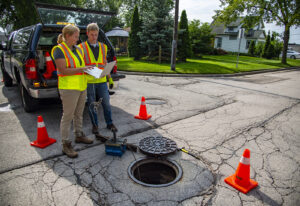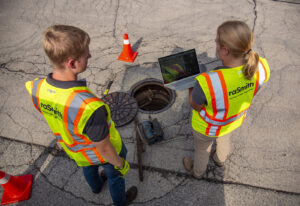Unseen Invaders: The Impact of Inflow and Infiltration on Our Sewer Systems
Inflow and Infiltration (I/I) involve the unwanted clear water entering the sewer system. Infiltration is groundwater seeping in through defects in sewer lines, while inflow is water from sources like foundation drains and downspouts entering the system.
I/I can strain wastewater treatment facilities, leading to increased operational costs and potential issues such as surcharging, basement backups, and overflows in combined sewer systems. Identifying and prioritizing areas with high levels of I/I is crucial for efficient fund allocation and system rehabilitation.
How Advanced Flow Monitoring Transforms Sewer System Analytics
 Flow monitoring is a process that utilizes cutting-edge sensor technologies within sewer pipes to measure water levels, velocity, and flow rates. This implementation allows for precise measurement of water flow, quantified in gallons per day, peak levels, and other critical metrics throughout a specified data collection period.
Flow monitoring is a process that utilizes cutting-edge sensor technologies within sewer pipes to measure water levels, velocity, and flow rates. This implementation allows for precise measurement of water flow, quantified in gallons per day, peak levels, and other critical metrics throughout a specified data collection period.
The Unseen Heroes of Urban Flow Monitoring
Flow monitoring equipment is designed to be unobtrusive, ensuring minimal disruption to the sewer system. It is versatile, fitting pipe diameters from 6 inches to 72 inches, making it suitable for both storm and sanitary sewers. Depending on the goals of data collection, the installation can range from a few months to multiple years.
The sensors operate using a calibrated pressure transducer to record data. The installation process is relatively quick, taking only a few hours at each location; however, it does require confined space entry into the sewer system to set up the equipment. Once installed, the equipment’s depth can be fine-tuned on-site to align with prevailing field conditions. To maintain data integrity, field crews regularly visit the meters for accurate data collection and to carry out any necessary maintenance tasks.
How Flow Meters Are Revolutionizing I/I Detection and Infrastructure Rehabilitation
Flow meters provide data for analyzing the sewer system, especially during rain events when I/I has an increased likelihood. By correlating flow data with rainfall, we can pinpoint specific sewer basins that require attention. Mapping these basins guides rehabilitation efforts, ensuring resources are directed effectively. Engineers then use this data to suggest specific investigations and repair methods, optimizing sewer infrastructure management and reducing I/I’s impact.
raSmith has released a blog titled “Revitalizing Communities: The Essential Role of Sanitary Sewer Rehabilitation Programs.” This informative piece explores the process of sewer rehabilitation and discusses the significant benefits and impacts that such programs have on communities. It provides an in-depth look at how these initiatives can rejuvenate local infrastructure and improve the quality of life for residents.

Flow monitoring data is instrumental in pinpointing problematic areas within sewer systems, facilitating the prioritization and enhancement of rehabilitation processes. This leads to improved efficiency and cost-effectiveness in sewer system management. Tailored flow monitoring projects, guided by expert recommendations from our engineering team, are designed to meet unique requirements and achieve specific rehabilitation objectives.
raSmith’s Expertise
raSmith offers a wealth of experience in sewer system management, providing services ranging from storm sewer pond overflow monitoring to in-depth sanitary sewer flow analysis. This expertise supports clients in the prioritization of rehabilitation tasks, ensuring effective improvements to their sewer infrastructure.
